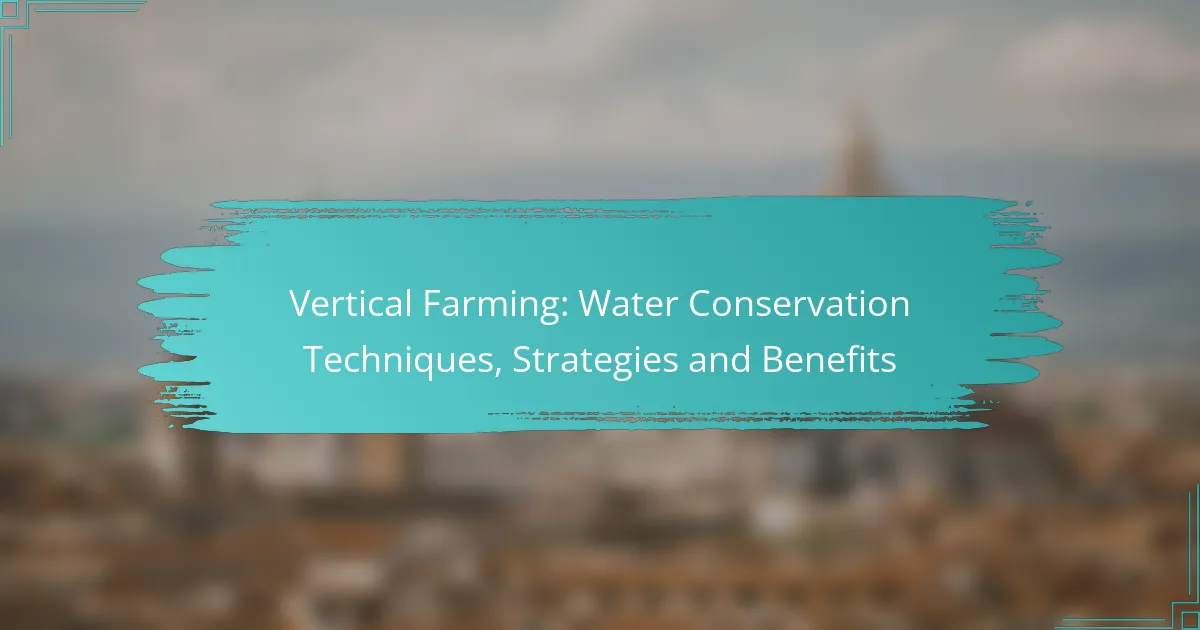Vertical farming represents a revolutionary approach to agriculture, particularly in its commitment to water conservation. By employing advanced technologies and efficient irrigation systems, these farms can achieve up to 90% reduction in water usage compared to traditional farming methods. This not only enhances productivity and reduces costs but also contributes positively to environmental sustainability.
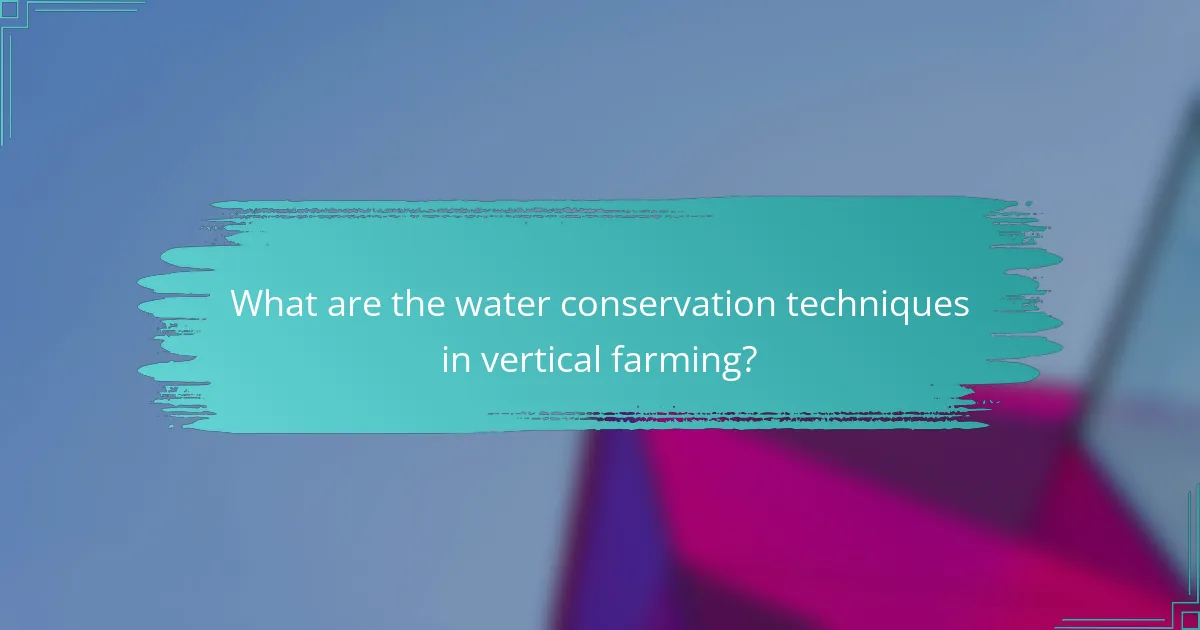
What are the water conservation techniques in vertical farming?
Water conservation techniques in vertical farming focus on minimizing water use while maximizing crop yield. These methods leverage advanced technologies and systems to ensure efficient water management, often resulting in significant savings compared to traditional farming practices.
Hydroponics systems
Hydroponics systems grow plants in nutrient-rich water instead of soil, allowing for precise control over water usage. This method can reduce water consumption by up to 90% compared to conventional agriculture, as the water is recirculated and reused. Growers should monitor nutrient levels and pH to maintain optimal plant health.
Aeroponics systems
Aeroponics systems suspend plants in air and mist their roots with nutrient solutions, which conserves water by minimizing evaporation. This technique can use up to 95% less water than traditional farming. Regular maintenance of the misting system is crucial to ensure even distribution and prevent root rot.
Drip irrigation methods
Drip irrigation delivers water directly to the plant roots through a network of tubes and emitters, significantly reducing water waste. This targeted approach can save 30-50% more water than traditional irrigation. It’s essential to regularly check for clogs and ensure the system is functioning properly to maximize efficiency.
Closed-loop water systems
Closed-loop water systems recycle water within the farming setup, capturing runoff and reusing it for irrigation. This method minimizes water loss and can lead to up to 90% water savings. Implementing filtration systems is important to keep the water clean and free from contaminants.
Rainwater harvesting
Rainwater harvesting involves collecting and storing rainwater for irrigation purposes, providing a sustainable water source. This technique can significantly reduce reliance on municipal water supplies, especially in regions with adequate rainfall. Proper storage and filtration systems are necessary to ensure the collected water is safe for plant use.
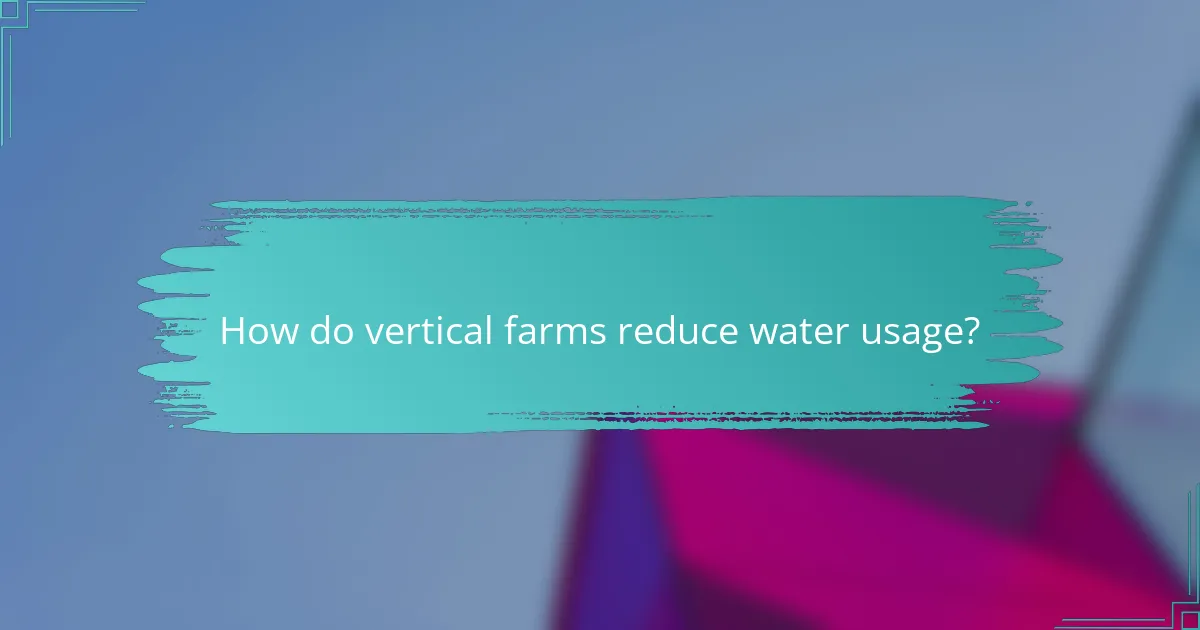
How do vertical farms reduce water usage?
Vertical farms significantly reduce water usage through advanced techniques that optimize water efficiency. By utilizing controlled environments and innovative systems, these farms can use up to 90% less water compared to traditional agriculture.
Efficient nutrient delivery
Vertical farms employ hydroponic and aeroponic systems to deliver nutrients directly to plant roots, minimizing water waste. These methods allow for precise control over nutrient concentration and water usage, ensuring that plants receive exactly what they need without excess runoff.
For instance, in hydroponics, water circulates through a closed system, allowing for nutrient absorption while preventing evaporation and spillage. This targeted approach can lead to healthier plants and higher yields with less water.
Minimized evaporation
In vertical farming, the controlled indoor environment significantly reduces evaporation compared to outdoor farming. By maintaining optimal humidity and temperature levels, vertical farms can keep water loss to a minimum.
Techniques such as using sealed growing chambers and humidity control systems help retain moisture. This not only conserves water but also creates a stable growing environment that can enhance plant growth rates.
Recycling water
Vertical farms often incorporate water recycling systems that capture and reuse water from irrigation and condensation. This closed-loop system can drastically lower overall water consumption by continuously filtering and redistributing water.
For example, excess water from plant trays can be collected, purified, and reused, ensuring that every drop counts. Implementing such systems can lead to significant cost savings and sustainability benefits in the long run.
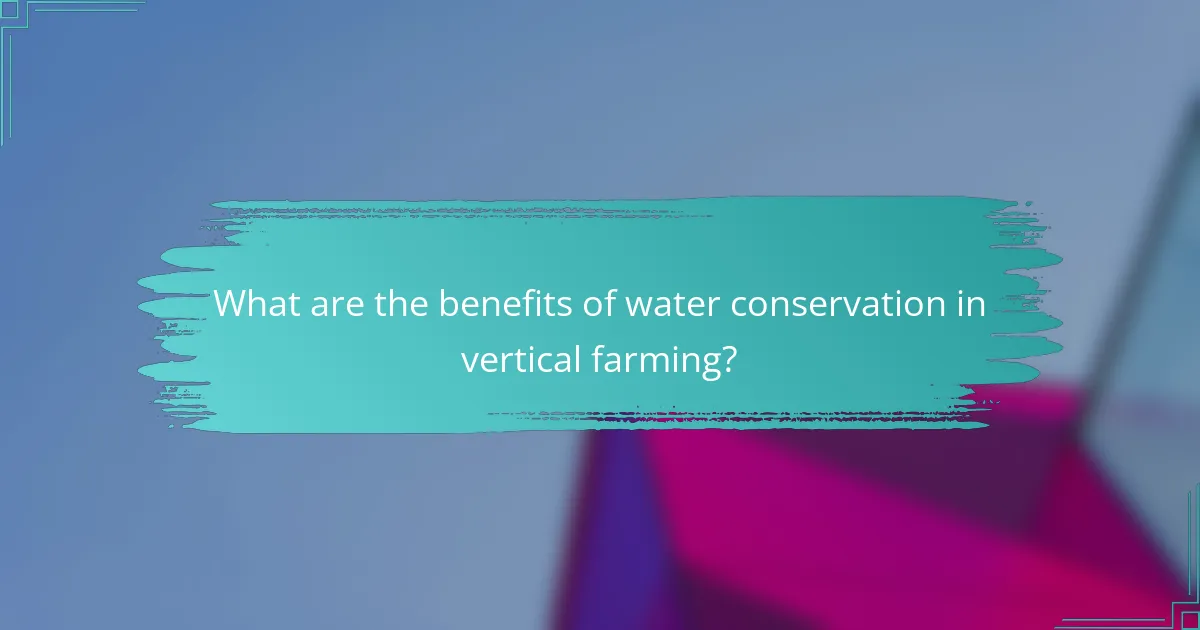
What are the benefits of water conservation in vertical farming?
Water conservation in vertical farming leads to enhanced productivity, reduced costs, and a positive environmental impact. By utilizing efficient irrigation techniques and recycling systems, vertical farms can significantly minimize water usage while maximizing crop output.
Increased crop yield
Water conservation techniques, such as hydroponics and aeroponics, allow for precise control over water delivery to plants, which can lead to increased crop yields. These methods ensure that plants receive the optimal amount of moisture, promoting faster growth and healthier produce.
For example, hydroponic systems can use up to 90% less water than traditional soil-based farming, while still producing higher quantities of food per square meter. This efficiency is crucial as urban populations grow and land becomes scarcer.
Lower operational costs
Implementing water conservation strategies can significantly lower operational costs for vertical farms. Reduced water usage translates to lower utility bills, which can be a substantial expense in agricultural operations.
Additionally, systems that recycle water can further decrease costs associated with water procurement and treatment. Farms that adopt these technologies often see a return on investment within a few years due to these savings.
Environmental sustainability
Water conservation in vertical farming contributes to environmental sustainability by reducing the strain on local water resources. Efficient water use minimizes runoff and pollution, which can harm surrounding ecosystems.
Moreover, vertical farms often utilize renewable energy sources and sustainable practices, making them a more eco-friendly option compared to traditional farming methods. This holistic approach helps mitigate climate change impacts and promotes biodiversity.
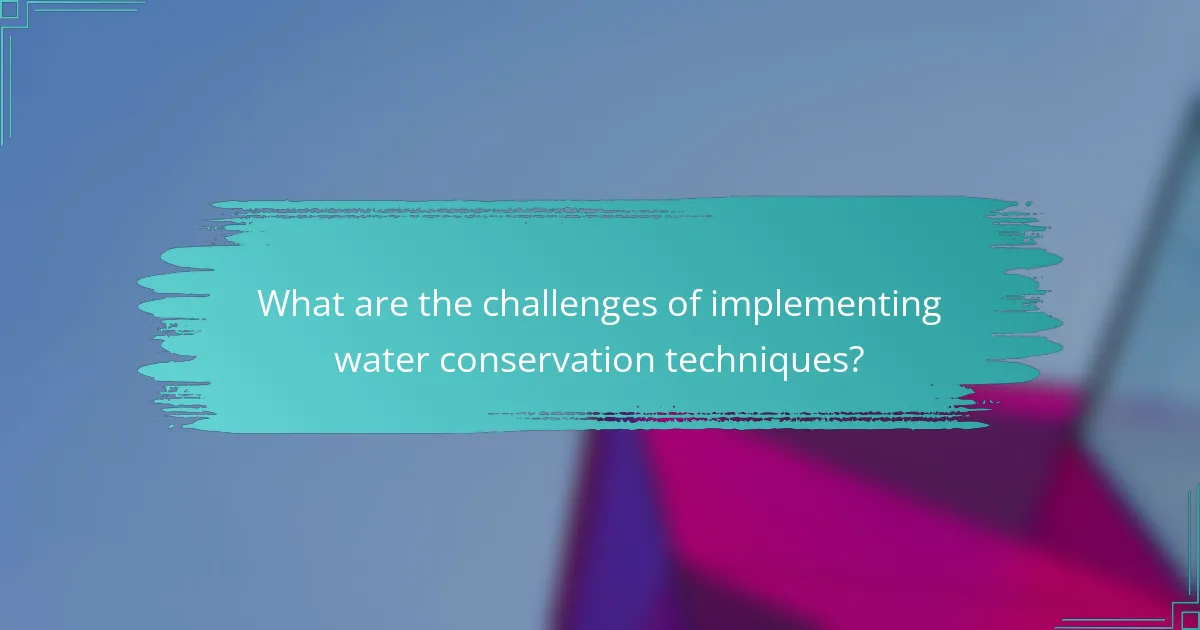
What are the challenges of implementing water conservation techniques?
Implementing water conservation techniques in vertical farming presents several challenges, including high initial costs, the need for specialized technical expertise, and ongoing maintenance requirements. Addressing these issues is crucial for the successful adoption of sustainable practices in urban agriculture.
Initial setup costs
The initial setup costs for water conservation systems can be significant, often ranging from thousands to tens of thousands of dollars depending on the technology used. Systems like hydroponics or aquaponics require investment in infrastructure, such as pumps, tanks, and filtration systems. Budgeting for these expenses is essential to ensure the long-term viability of the farming operation.
Farmers should consider potential funding options, such as grants or loans specifically aimed at sustainable agriculture, to help offset these costs. Additionally, calculating the return on investment (ROI) from reduced water usage can provide a clearer picture of the financial benefits over time.
Technical expertise requirements
Implementing effective water conservation techniques often requires specialized knowledge in areas such as system design, plant biology, and water chemistry. Farmers may need to invest in training or hire experts to ensure that systems are set up and managed correctly. This expertise is crucial for optimizing water use and maintaining plant health.
Collaboration with agricultural extension services or local universities can provide access to valuable resources and training programs. Networking with other vertical farmers can also facilitate knowledge sharing and problem-solving.
Maintenance of systems
Maintaining water conservation systems is critical for their efficiency and effectiveness. Regular monitoring and upkeep are necessary to prevent issues such as clogs, leaks, or imbalances in nutrient levels. Farmers should establish a maintenance schedule that includes routine inspections and cleaning of components.
Common pitfalls include neglecting system checks or failing to replace worn-out parts, which can lead to costly repairs or reduced crop yields. Developing a checklist for maintenance tasks can help ensure that all aspects of the system are regularly addressed, promoting sustainability and productivity in vertical farming operations.
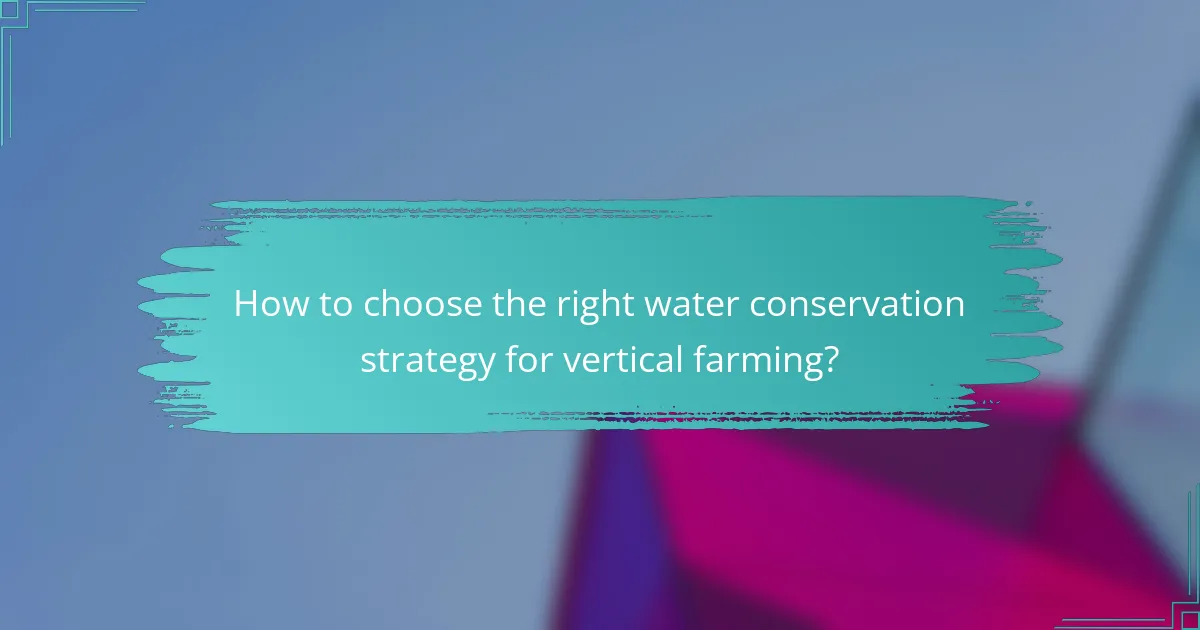
How to choose the right water conservation strategy for vertical farming?
Selecting the appropriate water conservation strategy for vertical farming involves understanding the specific needs of your crops, the available technology, and the local climate. Key considerations include the efficiency of water use, the cost of implementation, and the potential impact on crop yield.
Hydroponics
Hydroponics is a method that uses nutrient-rich water solutions instead of soil to grow plants. This technique allows for precise control over nutrient delivery and significantly reduces water usage, often using up to 90% less water compared to traditional farming. It is essential to monitor the nutrient concentration and pH levels regularly to ensure optimal plant growth.
Aeroponics
Aeroponics involves growing plants in an air or mist environment without the use of soil or aggregate medium. This method can conserve water by delivering nutrients directly to the roots through a fine mist, using about 95% less water than conventional farming. However, it requires careful management of misting cycles to prevent root rot and ensure adequate nutrient uptake.
Drip Irrigation
Drip irrigation is a highly efficient watering method that delivers water directly to the plant roots through a network of tubing and emitters. This technique minimizes evaporation and runoff, making it suitable for vertical farms. Regular maintenance of the system is crucial to prevent clogging and ensure consistent water delivery.
Water Recycling Systems
Implementing water recycling systems can significantly enhance water conservation in vertical farming. These systems collect and treat runoff water for reuse, reducing overall water consumption. It is important to ensure that the recycled water meets safety standards to avoid contaminating crops.
Rainwater Harvesting
Rainwater harvesting captures and stores rainwater for agricultural use, providing a sustainable water source. This method can supplement irrigation needs, especially in regions with seasonal rainfall. Proper storage and filtration systems are necessary to ensure the collected water is clean and suitable for plant growth.
